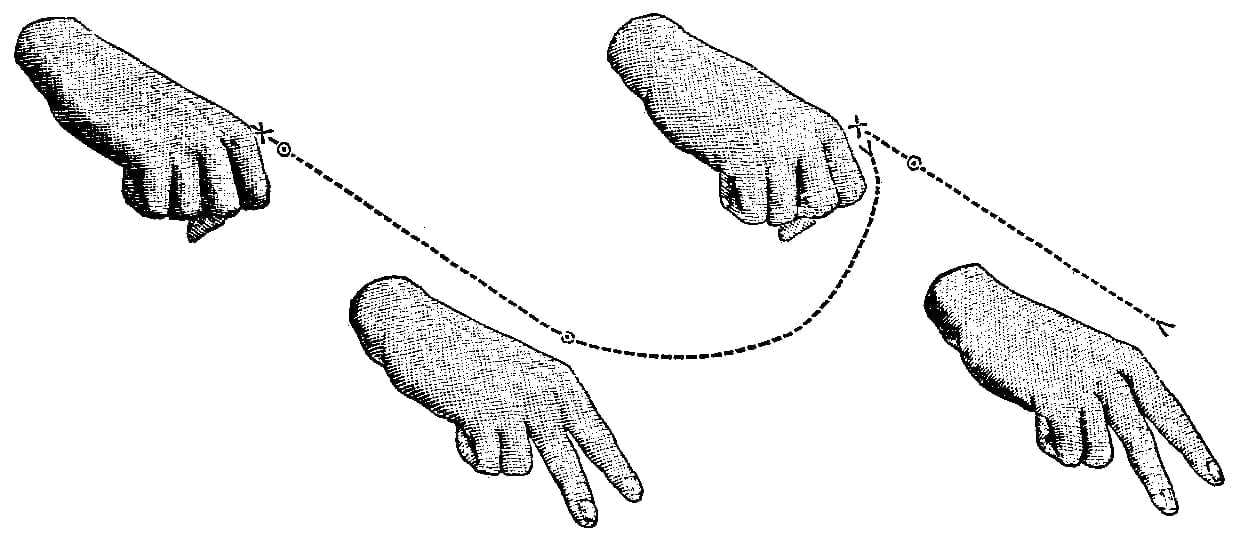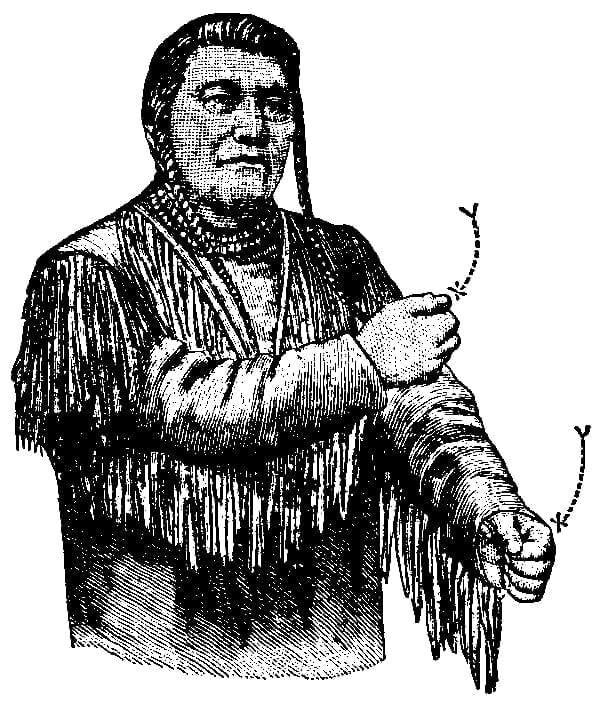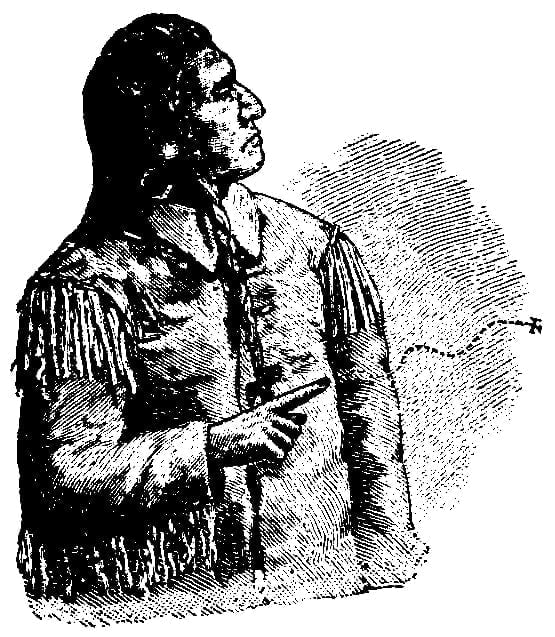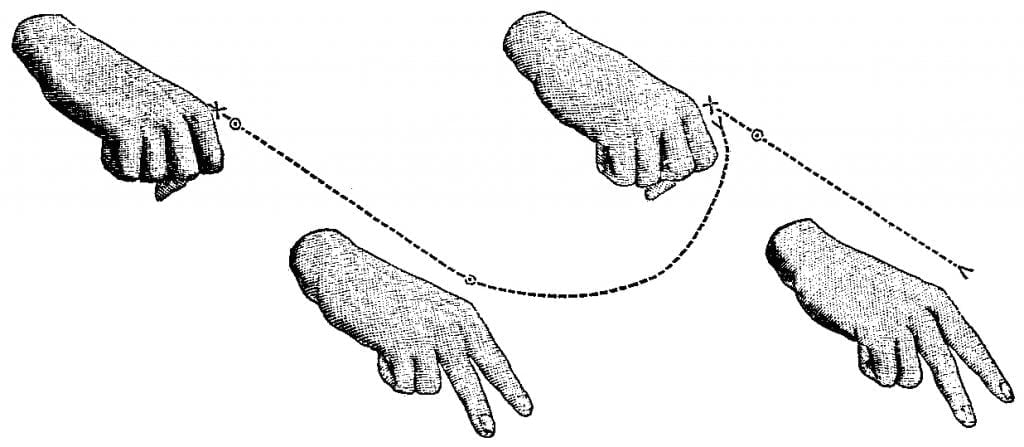Lipan
With the index and second fingers only extended and separated, hold the hand at arm’s length to the front of the left side; draw it back in distinct jerks; each time the hand rests draw the fingers back against the inside of the thumb, and when the hand is again started on the next movement backward snap the fingers to full length. This is repeated five or six times during the one movement of the hand. The country which the Lipans at one time occupied contained large ponds or lakes, and along the shores of these the reptile was found which gave them this characteristic appellation. (Kaiowa I; Comanche III; Apache III; WichitaII.) “Frogs.” Fig. 294.

Mandan
The first and second fingers of the right hand extended, separated, backs outward, other fingers and thumb closed, are drawn from the left shoulder obliquely downward in front of the body to the right hip. (Dakota I.) “The Mandan Indians are known to the Sioux as ‘The people who wear a scarlet sash, with a train,’ in the manner above described.”
Minitari, See Hidatsa
Nez Percés, See Sahaptin
Ojibwa, or Chippewa
Right hand horizontal, back outward, fingers separated, arched, tips pointing inward, is moved from right to left breast and generally over the front of the body with a trembling motion and at the same time a slight outward or forward movement of the hand as though drawing something out of the body, and then make the sign for Man, viz: The right-hand is held in front of the right breast with the forefinger extended, straight upright (J), with the back of the hand outward; move the hand upward and downward with finger extended. (Dakota I.) “Perhaps the first Chippewa Indian seen by a Sioux had an eruption on his body, and from that his people were given the name of the ‘People with a breaking out,’ by which name the Chippewas have ever been known by the Sioux.”
Osage, or Wasaji
Pull at the eyebrows over the left eye with the thumb and forefinger of the left hand. This sign is also used by the Osages themselves. (Sac, Fox, and Kickapoo I.)
Hold the flat right hand, back forward, with the edge pointing backward, against the side of the head, then make repeated cuts, and the hand is moved backward toward the occiput. (Kaiowa I; Comanche III; Apache II; Wichita II.) “Former custom of shaving the hair from the sides of the head, leaving but an occipito-frontal ridge.”
Pass the flat and extended right hand backward over the right side of the head, moving the index against the second finger in imitation of cutting with a pair of scissors. (Comanche II.) “Represents the manner of removing the hair from the sides of the head, leaving a ridge only from the forehead to the occiput.”
Outagami, See Fox
Pani (Pawnee)
Imitate a wolf’s ears with the two forefingers of the right hand extended together, upright, on the left side of the head. (Burton.)
Place a hand on each side of the forehead, with two fingers pointing to the front to represent the narrow, sharp ears of the wolf. (Marcy in Prairie Traveler, p. 215.)
Extend the index and second fingers of the right hand upward from the right side of the head. (Arapaho II; Cheyenne V; Dakota VII, VIII; Ponka II; Pani I; Comanche II.)
Right hand, as (N), is passed from the back part of the right side of the head, forward seven or eight inches. (Dakota I.) “The Pani Indians are known as the Shaved-heads, i.e., leaving only the scalp locks on the head.”
First and second fingers of right hand, straight upward and separated, remaining fingers and thumb closed (as in N), like the ears of a small wolf. (Dakota III.)
Place the closed right hand to the side of the temple, palm forward leaving the index and second fingers extended and slightly separated, pointing upward. This is ordinarily used, though, to be more explicit, both hands may be used. (Kaiowa I; Comanche III; Ute I; Apache II; WichitaII.) For illustration see Fig. 336, facing page 531.
Pend D’Oreille, or Calispel
Make the motion of paddling a canoe. (Kutine I.)
Both fists are held as if grasping a paddle vertically downward and working a canoe. Two strokes are made on each side of the body from the side backward. (Shoshoni and Banak I.) Fig. 295.

Pueblo
Place the clinched hand back of the occiput as if grasping the queue, then place both fists in front of the right shoulder, rotating them slightly to represent a loose mass of an imaginary substance. Represents the large mass of hair tied back of the head. (Arapaho II; Cheyenne V.)
Ree, See Arikara
Sac, or Sauki
Pass the extended palm of the right hand over the right side of the head from front to back, and the palm of the left hand in the same manner over the left side of the head. (Sac, Fox, and Kickapoo I.) “Shaved-headed Indians.”
Sahaptin, or Nez Percés
The right index, back outward, passed from right to left under the nose. Piercing the nose to receive the ring. (Creel; Dakota I.)
Place the thumb and forefinger to the nostrils. (KutineI.)
Close the right hand, leaving the index straight but flexed at right angles with the palm; pass it horizontally to the left by and under the nose. (Comanche II.) “Pierced nose.” Fig. 296. This sign is made by the Nez Percés for themselves, according to Major Haworth. Information was received from Arapaho and Cheyenne Indians, who visited Washington in 1880, that this sign is also used to designate the Caddos, who practiced the same custom of perforating the nasal septum. The same informants also state that the Shawnees are sometimes indicated by the same sign.

Pass the extended index, pointing toward the left, remaining fingers and thumb closed, in front of and across the upper lip, just below the nose. The second finger is also sometimes extended. (Shoshoni and Banak I.) “From the custom of piercing the noses for the reception of ornaments.”
See p. 345 for remarks upon the signs for Sahaptin.
Satsika, See Blackfeet
Selish, See Flathead
Sheepeater, See under Shoshoni
Shawnee, See remarks under Sahaptin
Shoshoni, or Snake
The forefinger is extended horizontally and passed along forward in a serpentine line. (Long.)
Right hand closed, palm down, placed in front of the right hip; extend the index and push it diagonally toward the left front, rotating it quickly from side to side in doing so. (Absaroka I; Shoshoni and Banak I.) “Snake.” Fig. 297.

Right hand, horizontal, flat, palm downward (W), advanced to the front by a motion to represent the crawling of a snake. (Dakota III.)
With the right index pointing forward, the hand is to be moved forward about a foot in a sinuous manner, to imitate the crawling of a snake. Also made by the Arapahos. (Dakota IV.)
Place the closed right hand, palm down, in front of the right hip; extend the index, and move it forward and toward the left, rotating the hand and finger from side to side in doing so. (Kaiowa I; Comanche II, III; Apache II; Wichita II.)
Make the motion of a serpent with the right finger. (Kutine I.)
Close the right hand, leaving the index only extended and pointing forward, palm to the left, then move it forward and to the left. (Pai-Ute I.) The rotary motion of the hand does not occur in this description, which in this respect differs from the other authorities.
Sheepeater or Tukuarikai
Both hands, half closed, pass from the top of the ears backward, downward, and forward, in a curve, to represent a ram’s horns; then, with the index only extended and curved, place the hand above and in front of the mouth, back toward the face, and pass it downward and backward several times. (Shoshoni and BanakI.) “Sheep,” and “to eat.”


